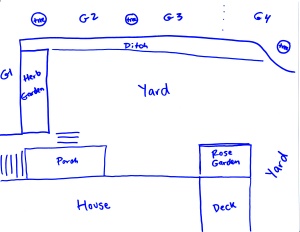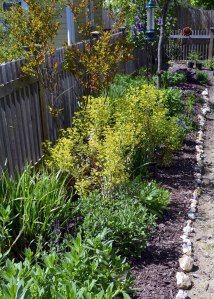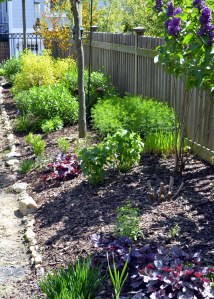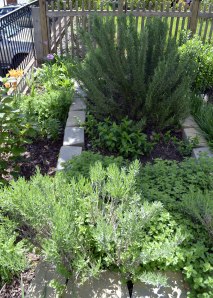Winter is a time of reflection, and spring is a time of action. During the past couple of months in the garden, it’s been all about putting everything in order (weeding, pruning, weeding, relocating, more weeding, planting, edging, weeding, expanding, mulching, and a bit more weeding).
As I mentioned when I started the blog last year, we live in a townhouse and are lucky to have a tiny bit of land surrounding it in which to plant things. A large portion of the available space for flower beds is long and straight, bordered by a wooden fence we share with a neighbor on one side, and a drainage ditch on the other (county mandated). Luckily, the space is broken up by three trees. When we moved in, there was nothing but grass. The first spring in our townhouse (2010, Phase 1), we created a narrow flower bed (G1) along a short side of our yard and put in two flower beds parallel to the long wooden fence (G2 and G3). In 2011 (Phase 2), the children built a small herb garden on Mother’s Day next to G1, and I filled out G2 a bit more. In 2012, I built upon lessons learned in 2011, and continued to add to the three flower beds (especially G3) and the herb garden. That was Phase 3.

Chicken-scratch version of main parts of Garden Layout, hopelessly out of scale….
Phase 4 (Spring 2013) has thus far entailed a lot of transplanting–moving plants to locations better suited to their temperaments and space requirements. The feisty Porcupine Grass plants on either side of the Crape Myrtle (G2) were in danger of smothering it, so we dug them up and moved them a couple feet farther away in each direction while they were still dormant. They are now happily growing away in their new spots. The Montauk Daisies (G2) were also smothering everything in their paths, so we repositioned them so they were perpendicular to the fence rather than parallel to it; there was plenty of space in the back for them to do their thing, and that opened up space at the front of the flower bed. I fell in love with the Witch Hazels at Brookside Gardens and contrary to what I said, I decided not to admire them from afar. For better or worse, there is now a fine specimen growing in G1, though that meant moving a few plants to G3.
In Spring 2013, we also welcomed in the new. The entire family was here just before Easter (one son home from graduate school along with his girlfriend, another son back from college, and the two high-schoolers and a professor husband on spring break), and what did they do? They all spent part of their vacation helping to build a small Rose Garden along one side of the raised deck (the deck, porch, and entrance to the house are about 4 feet above garden level). I transplanted two existing roses into the new garden, and added four more. To top it off, last weekend I planted some vegetables in and around the roses. An odd combination, I know, but the Rose Garden is in a prime sunny spot, and it was looking a bit bare with just the roses, so I decided to be unconventional and go with vegetables: eggplant, tomatoes at the very back against the wall of the deck, and zucchini–everything I need for a nice ratatouille. (In my defense, tomatoes are supposed to help prevent black spot….). I’ll see what lessons I learn from this experiment. But a very huge thank you to my husband and the younger generation for making it all possible.
Adding to our expansion efforts, we removed a hammock that was along the far back portion of the fence adjacent to G3, dug up the earth and added manure, compost, and gypsum (since our house essentially sits on a mound of clay), and started a new flower bed there (G4), which wraps around a corner where the third tree is. It is still under construction, but I did get some bulbs in (Gladioli and Lilies), plus a Camellia, some Hostas, more Echinacea to accompany the lone surviving Double Scoop Bubble Gum, and some Astilbe, with two peonies still waiting to be planted (today, I hope).
As a finishing touch (though no garden is ever finished), I dug out the leaf- and old mulch-filled drainage ditch, lined the garden side with stones to prevent the mulch from falling into the ditch (the stones all emerged when we created the various flower beds–so our house actually sits on a clay and stone base), and then set up a small fence all around the flower gardens to keep the rampaging Schnauzers from killing the emerging and new plants. And that’s all for now…. Probably far more than you ever wanted to know. But the end result is and will be a pleasure to behold for those of us who are happy just watching things grow.

G2 (with G3 and new G4 in background), ditch to right:
Montauks, Salvia, Gaillardia, Porcupine Grass, Crape Myrtle,
Euphorbia

G3 (with G2 in background): Heuchera, Blue-eyed Grass, Variegated
Sage, Aster, Lilacs, Hyssop, Butterfly Weed, Tickseed, Verbena
Bonariensis, and old Hibiscus (Kopper King) stumps

Herb Garden (with G1 to the left): Lavender, Oregano, invisible but
newly planted Basil, Mint, exploding Rosemary, and wayward Cilantro
growing in G1
Tags: flower beds along a fence, garden design, herb garden, long flower beds, narrow flower beds, planting by a fence, small gardens, spring cleaning





















